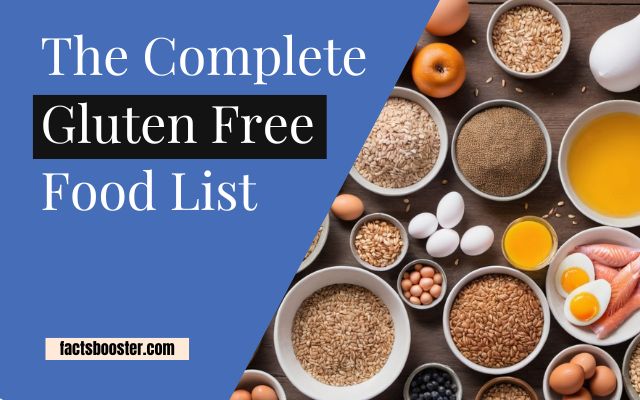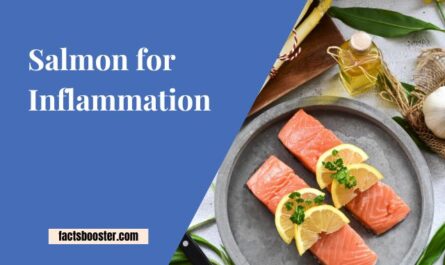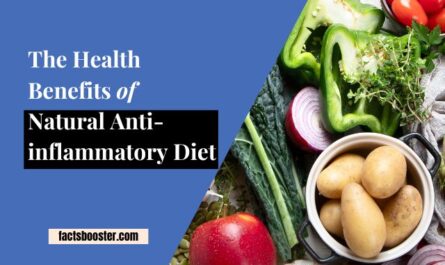Gluten free food list is essential, as gluten-free diet has gained momentum for its essential role in managing health conditions like Celiac Disease and gluten sensitivity. This shift accommodates dietary needs and opens a realm of delicious, healthy eating opportunities.
Navigating the landscape of gluten-free nutrition enhances well-being for those affected, laying the groundwork for a detailed exploration of safe, diverse food choices.
Key Takeaways:
- Understanding gluten’s impact is crucial for those with specific health conditions.
- A varied gluten-free diet offers rich, nutritional benefits.
- Adopting a gluten-free lifestyle need not be limiting, as a wide range of options exists.

What is Gluten
Gluten stands as a protein composite primarily found in wheat, barley, and rye. Its presence gives dough its elasticity, aiding foods in maintaining their shape. For those diagnosed with Celiac Disease or exhibiting gluten sensitivity, ingestion can lead to severe health complications.
This necessitates a strict gluten-free diet to avert adverse reactions, underlining the critical need for awareness and vigilance in dietary choices.
Is Gluten Bad for You
For individuals with Celiac Disease or gluten sensitivity, avoiding gluten proves essential for their well-being (1). Gluten, a protein found in wheat, barley, and rye, triggers serious health problems in these groups. (2)
Thus, adhering to a gluten-free diet emerges not merely as a lifestyle preference but as a crucial need for maintaining health and avoiding adverse symptoms. This dietary shift holds the power to transform lives by elevating well-being and mitigating disease-related discomfort.
Misconceptions About Gluten-Free Foods
Many believe a gluten-free diet equates to automatic health benefits. This myth leads to the assumption that all gluten-free products are inherently healthier, ignoring that these products can often contain high sugar or fat levels.
Another misconception casts the gluten-free lifestyle as restrictive. In truth, this lifestyle opens doors to exploring a diverse range of nutritious foods. By focusing on naturally gluten-free grains, fruits, and vegetables, individuals discover a world of flavorful, healthy eating options.
Read more:
Gluten Free Food List
Embarking on a gluten-free journey often feels daunting at first. You may worry about the limitations it places on your diet. However, this gluten free food list will unveil the diverse, savory, and wholesome options.
Choices abound, from grains and flours like buckwheat and sorghum to a plethora of fruits, vegetables, and proteins that enrich your meals. This guide promises to show that a gluten-free lifestyle can indeed be both flavorful and nourishing.
Grains and Flours
- Rice
- Quinoa
- Buckwheat
- Sorghum
- Millet
Embarking on a gluten-free lifestyle necessitates finding alternatives for wheat-based staples. Rice, a versatile grain, serves as a cornerstone for numerous gluten-free recipes.
Its neutral taste and adaptability make it a favorite among those adhering to a gluten-free diet. Quinoa boasts a rich profile of amino acids, essential for a balanced Celiac Disease diet, while adding a nutty flavor to meals.
Despite its name, Buckwheat remains free from gluten, offering a hearty option for pancakes and noodles. Sorghum and Millet have emerged as nutritious alternatives, enriching gluten-free cooking with their diverse uses and health advantages. (3)
Fruits and Vegetables
- Fresh Fruits
- Leafy Greens
- Root Vegetables
- Cruciferous Vegetables
Adopting a gluten-free lifestyle entails incorporating a wide array of fruits and vegetables. These components prove crucial in achieving a balanced and nutritious diet.
Fresh fruits rejuvenate with their rich vitamin content, offering endless options for snacking and meal enhancements. Leafy greens, packed with minerals, fortify meals with their nutrient density.
Including root vegetables ensures a hearty dose of fiber, while cruciferous vegetables provide essential antioxidants. Embrace these staples for a holistic approach to gluten-free nutrition.
Proteins
- Meat and Poultry
- Fish and Seafood
- Eggs
- Legumes and Beans
- Nuts and Seeds
Incorporating gluten-free protein sources into your diet ensures a balance of essential nutrients. Meat and poultry stand as pillars of protein, devoid of gluten, fortifying muscle health and aiding in repair.
Fish and seafood offer a bounty of omega-3 fatty acids, crucial for heart health and cognitive function. Eggs, versatile and rich in vitamins, blend seamlessly into a gluten-free lifestyle.
Legumes and beans, along with nuts and seeds, not only provide plant-based protein but also fiber, making them indispensable for digestive well-being.
Dairy
- Milk and Cream
- Cheese
- Yogurt
- Plant-Based Milk Alternatives
Embarking on a gluten-free lifestyle does not mean you must forgo the creamy delights of dairy and its alternatives. You will find a plethora of milk and cream, cheese, yogurt, and plant-based milk substitutes that cater to this dietary need.
These options not only ensure your meals remain diverse and tasty but also contribute significantly to your gluten-free nutrition. Incorporating them into gluten-free recipes enhances flavor and texture, offering a seamless transition to a healthier, gluten-sensitive diet.
Snacks
- Gluten-Free Chips and Crackers
- Gluten-Free Baked Goods
- Fruits and Nut Mixes
- Gluten-Free Desserts
In your quest for a gluten-free lifestyle, discovering delicious alternatives to traditional snacks is thrilling. Gluten-free chips and crackers offer savory satisfaction without the worry. For a sweet treat, consider gluten-free baked goods; they’re as delectable as their gluten-filled counterparts.
If you prefer something fresh, fruits and nut mixes provide a nutritious crunch. Lastly, indulge in gluten-free desserts, a testament to the variety and joy found in a gluten-free diet.
Beverages
You have a wealth of choices for hydrating and enjoyable beverages within a gluten-free lifestyle.
- Water and Infused Water: Always safe, these options offer endless flavor variations with added fruits or herbs.
- Coffee and Tea: Naturally gluten-free, but always verify any added flavors or blends for hidden gluten.
- Gluten-Free Smoothies and Juices: Perfect for nutrition on-the-go. Use fresh, uncontaminated ingredients to avoid gluten cross-contamination.
Remember, vigilance in preparation prevents accidental gluten introduction, ensuring your drinks remain both delightful and safe.
Gluten-Free Cooking Tips
Adopting a gluten-free diet necessitates vigilance in the kitchen. You must scrutinize food labels for hidden gluten, often lurking under names unfamiliar to many. Ensuring your meals remain uncontaminated, practice strict separation in cookware and utensils used.
Embrace the challenge of finding creative substitutes for gluten-containing staples. This approach, over time, transforms into an effortless, healthy gluten-free lifestyle, nourished by a wide array of delicious, safe options.
Reading Labels
You hold the key to navigating the gluten-free landscape in the palm of your hand every time you pick up a product. Mastering label reading is essential. Look for clear labeling that indicates a product is free from gluten.
Still, vigilance is your best ally; manufacturers often change their recipes or production methods. Inspect for hidden sources of gluten under names like ‘malt,’ ‘brewer’s yeast,’ or ‘hydrolyzed vegetable protein,’ which can slip under the radar.
Awareness and knowledge serve as your guardians in the gluten-free journey, minimizing the risk of accidental gluten ingestion.
Avoiding Cross-Contamination
Adopting a gluten-free lifestyle necessitates vigilant measures to ward off cross-contamination. Essential steps include dedicating specific cookware and utensils solely for gluten-free meal preparation.
This strategy ensures that gluten residues, which likely linger on shared kitchen tools, do not accidentally taint your gluten-free dishes. Equally crucial is the thorough cleaning of all surfaces before cooking begins.
A routine scrubbing using dedicated sponges and cleaning agents can significantly reduce the risk, making your kitchen a safe space for gluten-free cooking. Through these measures, you embrace a healthy gluten-free eating journey, free from the worries of unintentional gluten intake.
Substituting Ingredients
Mastering the craft of gluten-free cooking and baking opens up a world of flavors and textures you may have thought were off-limits. For novices and seasoned cooks alike, the art of substitution has proven transformative.
Opting for ingredients like rice flour or almond meal can reinvent classic recipes into gluten-free wonders. Quinoa and buckwheat, despite their names, offer fantastic alternatives to traditional grains and flours.
Embrace the challenge; you’ll find that such swaps not only maintain but can enhance the nutritional value of your dishes. Experimentation in the kitchen becomes both a necessity and a joy, pushing boundaries and expanding your culinary repertoire to include a vast array of gluten-free recipes.
Conclusion
Throughout this journey, you have discovered the vast spectrum of delicious and nutritious options a gluten-free diet offers. Embracing a lifestyle free from gluten, whether due to health necessities like Celiac Disease or a personal choice, has never seemed more accessible.
By exploring gluten-free food lists, cooking tips, and meal planning ideas, you are well-equipped to enjoy a healthy gluten-free lifestyle full of variety and flavor. Dive into the world of gluten-free eating and let the benefits of improved health and wellness unfold.


